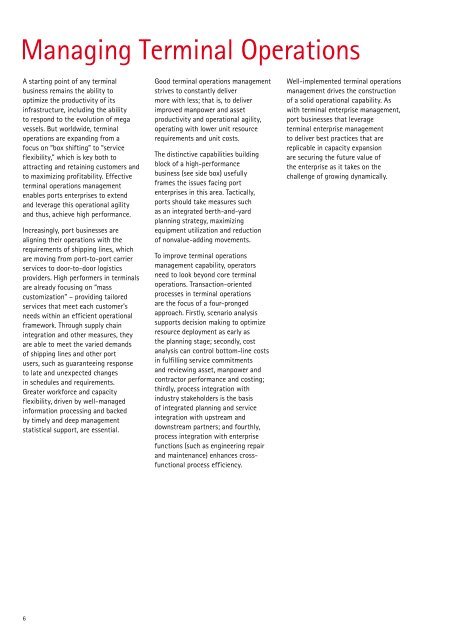Transformation to Enable High Performance in Ports
Transformation to Enable High Performance in Ports
Transformation to Enable High Performance in Ports
Create successful ePaper yourself
Turn your PDF publications into a flip-book with our unique Google optimized e-Paper software.
Manag<strong>in</strong>g Term<strong>in</strong>al Operations<br />
A start<strong>in</strong>g po<strong>in</strong>t of any term<strong>in</strong>al<br />
bus<strong>in</strong>ess rema<strong>in</strong>s the ability <strong>to</strong><br />
optimize the productivity of its<br />
<strong>in</strong>frastructure, <strong>in</strong>clud<strong>in</strong>g the ability<br />
<strong>to</strong> respond <strong>to</strong> the evolution of mega<br />
vessels. But worldwide, term<strong>in</strong>al<br />
operations are expand<strong>in</strong>g from a<br />
focus on “box shift<strong>in</strong>g” <strong>to</strong> “service<br />
flexibility,” which is key both <strong>to</strong><br />
attract<strong>in</strong>g and reta<strong>in</strong><strong>in</strong>g cus<strong>to</strong>mers and<br />
<strong>to</strong> maximiz<strong>in</strong>g profitability. Effective<br />
term<strong>in</strong>al operations management<br />
enables ports enterprises <strong>to</strong> extend<br />
and leverage this operational agility<br />
and thus, achieve high performance.<br />
Increas<strong>in</strong>gly, port bus<strong>in</strong>esses are<br />
align<strong>in</strong>g their operations with the<br />
requirements of shipp<strong>in</strong>g l<strong>in</strong>es, which<br />
are mov<strong>in</strong>g from port-<strong>to</strong>-port carrier<br />
services <strong>to</strong> door-<strong>to</strong>-door logistics<br />
providers. <strong>High</strong> performers <strong>in</strong> term<strong>in</strong>als<br />
are already focus<strong>in</strong>g on “mass<br />
cus<strong>to</strong>mization” – provid<strong>in</strong>g tailored<br />
services that meet each cus<strong>to</strong>mer’s<br />
needs with<strong>in</strong> an efficient operational<br />
framework. Through supply cha<strong>in</strong><br />
<strong>in</strong>tegration and other measures, they<br />
are able <strong>to</strong> meet the varied demands<br />
of shipp<strong>in</strong>g l<strong>in</strong>es and other port<br />
users, such as guarantee<strong>in</strong>g response<br />
<strong>to</strong> late and unexpected changes<br />
<strong>in</strong> schedules and requirements.<br />
Greater workforce and capacity<br />
flexibility, driven by well-managed<br />
<strong>in</strong>formation process<strong>in</strong>g and backed<br />
by timely and deep management<br />
statistical support, are essential.<br />
6<br />
Good term<strong>in</strong>al operations management<br />
strives <strong>to</strong> constantly deliver<br />
more with less; that is, <strong>to</strong> deliver<br />
improved manpower and asset<br />
productivity and operational agility,<br />
operat<strong>in</strong>g with lower unit resource<br />
requirements and unit costs.<br />
The dist<strong>in</strong>ctive capabilities build<strong>in</strong>g<br />
block of a high-performance<br />
bus<strong>in</strong>ess (see side box) usefully<br />
frames the issues fac<strong>in</strong>g port<br />
enterprises <strong>in</strong> this area. Tactically,<br />
ports should take measures such<br />
as an <strong>in</strong>tegrated berth-and-yard<br />
plann<strong>in</strong>g strategy, maximiz<strong>in</strong>g<br />
equipment utilization and reduction<br />
of nonvalue-add<strong>in</strong>g movements.<br />
To improve term<strong>in</strong>al operations<br />
management capability, opera<strong>to</strong>rs<br />
need <strong>to</strong> look beyond core term<strong>in</strong>al<br />
operations. Transaction-oriented<br />
processes <strong>in</strong> term<strong>in</strong>al operations<br />
are the focus of a four-pronged<br />
approach. Firstly, scenario analysis<br />
supports decision mak<strong>in</strong>g <strong>to</strong> optimize<br />
resource deployment as early as<br />
the plann<strong>in</strong>g stage; secondly, cost<br />
analysis can control bot<strong>to</strong>m-l<strong>in</strong>e costs<br />
<strong>in</strong> fulfill<strong>in</strong>g service commitments<br />
and review<strong>in</strong>g asset, manpower and<br />
contrac<strong>to</strong>r performance and cost<strong>in</strong>g;<br />
thirdly, process <strong>in</strong>tegration with<br />
<strong>in</strong>dustry stakeholders is the basis<br />
of <strong>in</strong>tegrated plann<strong>in</strong>g and service<br />
<strong>in</strong>tegration with upstream and<br />
downstream partners; and fourthly,<br />
process <strong>in</strong>tegration with enterprise<br />
functions (such as eng<strong>in</strong>eer<strong>in</strong>g repair<br />
and ma<strong>in</strong>tenance) enhances crossfunctional<br />
process efficiency.<br />
Well-implemented term<strong>in</strong>al operations<br />
management drives the construction<br />
of a solid operational capability. As<br />
with term<strong>in</strong>al enterprise management,<br />
port bus<strong>in</strong>esses that leverage<br />
term<strong>in</strong>al enterprise management<br />
<strong>to</strong> deliver best practices that are<br />
replicable <strong>in</strong> capacity expansion<br />
are secur<strong>in</strong>g the future value of<br />
the enterprise as it takes on the<br />
challenge of grow<strong>in</strong>g dynamically.

















